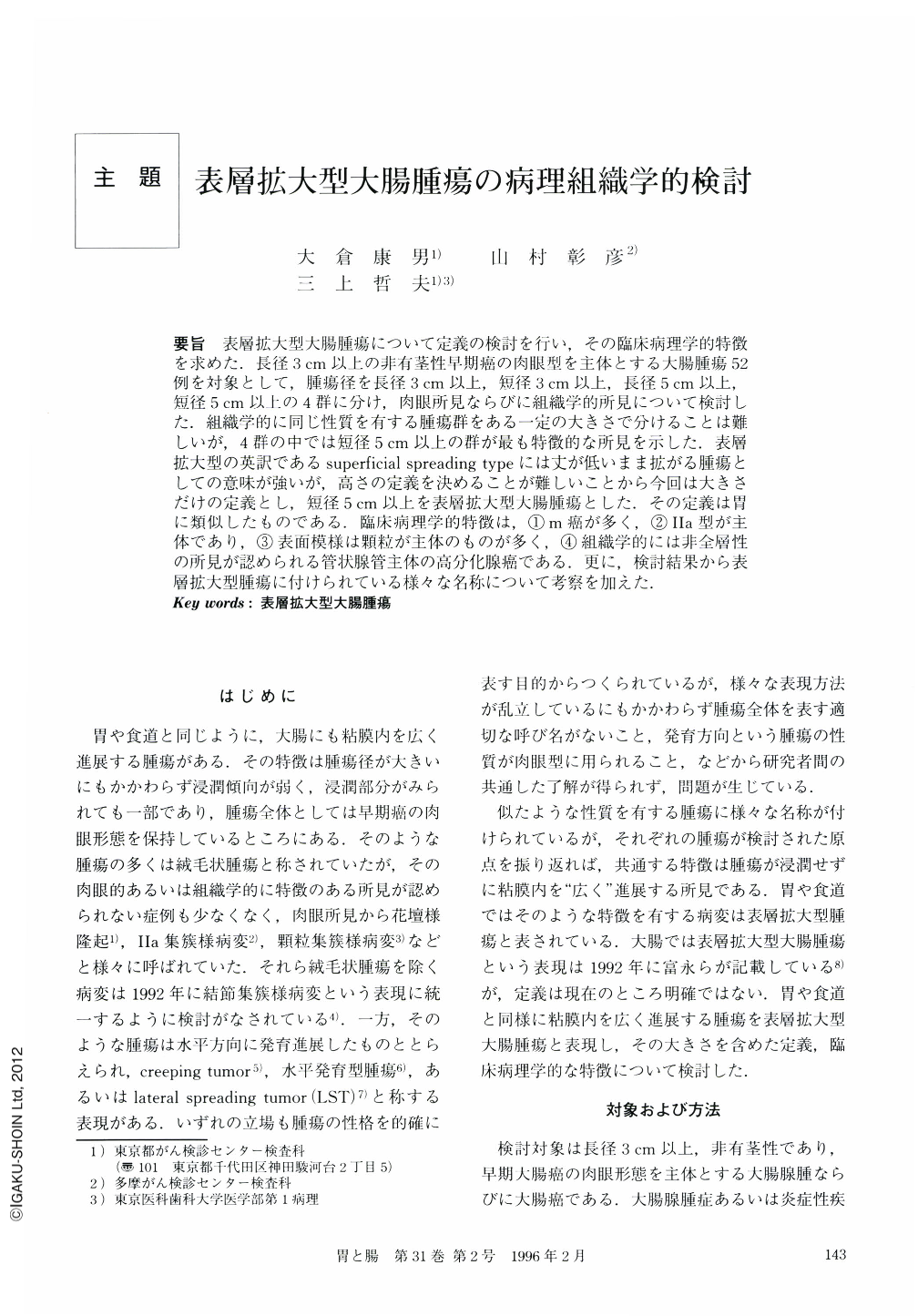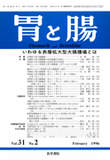Japanese
English
- 有料閲覧
- Abstract 文献概要
- 1ページ目 Look Inside
- サイト内被引用 Cited by
要旨 表層拡大型大腸腫瘍について定義の検討を行い,その臨床病理学的特徴を求めた.長径3cm以上の非有茎性早期癌の肉眼型を主体とする大腸腫瘍52例を対象として,腫瘍径を長径3cm以上,短径3cm以上,長径5cm以上,短径5cm以上の4群に分け,肉眼所見ならびに組織学的所見について検討した.組織学的に同じ性質を有する腫瘍群をある一定の大きさで分けることは難しいが,4群の中では短径5cm以上の群が最も特徴的な所見を示した.表層拡大型の英訳であるsuperficial spreading typeには丈が低いまま拡がる腫瘍としての意味が強いが,高さの定義を決めることが難しいことから今回は大きさだけの定義とし,短径5cm以上を表層拡大型大腸腫瘍とした.その定義は胃に類似したものである.臨床病理学的特徴は,①m癌が多く,②Ⅱa型が主体であり,③表面模様は顆粒が主体のものが多く,④組織学的には非全層性の所見が認められる管状腺管主体の高分化腺癌である.更に,検討結果から表層拡大型腫瘍に付けられている様々な名称について考察を加えた.
Superficial spreading type of colorectal epithelial tumors sometimes seemed the same as tumors of the esophagus and stomach. But the nature of these colorectal tumors was not defined. Fifty-two cases of spreading type colorectal tumors more than 3 cm in maximum diameter found in Tokyo Metropolitan Cancer Detection Center and Tama Cancer Detection Center were examined histopathologically. Invasion depth of the tumors showed that one case was a villotubular adenoma, 31 cases were mucosal carcinoma, 17 cases were submucosal invasive tumors, 2 cases were propria muscle invasive, and 2 cases were subserosal invasive. In the examination, the tumors were divided into four groups, of which A group was more than 3 cm in maximum diameter, B group was more than 3 cm in minimum diameter, C group was more than 5 cm in maximum diameter, and D group was more than 5 cm in minimum diameter. The number of cases of each groups were 52, 29, 20 and 6 respectively.
From macroscopical examination in all cases of A group, the common features of superficial spreading type of colorectal tumors were not revealed, but histological examination showed widely spread atypical glands in the upper portion of the mucosa. Similar findings were revealed in B and C group. In D group, several common features were found. They were 1) most of the tumors were mucosal carcinoma, 2) main macroscopic figure was superficially elevated type (Ⅱa type), 3) macroscopical appearance was mainly granular colonic area, 4) histopathogically, well differentiated carcinoma, mainly tubular type.
It was thought that, as in the case of esophageal cancers it is necessary to define the height of these tumors. However, as the size of the cancers was not able to be assessed objectively, we defined superficial spreading type of colorectal epithelial tumors as being at least more than 5 cm in minimum diameter.
According to this definition, such tumor cases were relatively few in number. Nevertheless, we considered it as suitable for revealing the most histopathological features of superficial spreading type of colorected epithelial tumor.

Copyright © 1996, Igaku-Shoin Ltd. All rights reserved.


